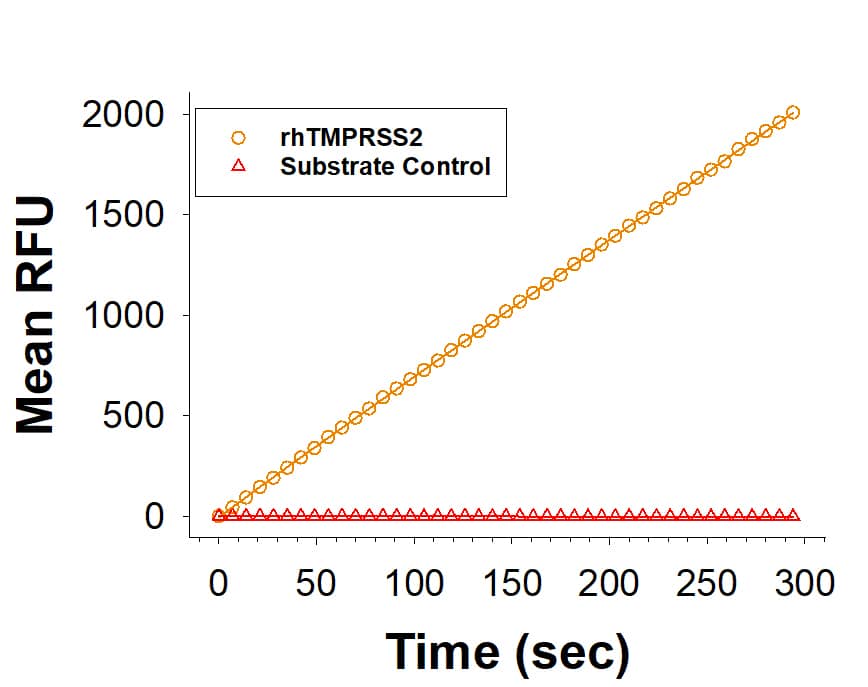Recombinant Human TMPRSS2 His-tag Protein, CF
R&D Systems, part of Bio-Techne | Catalog # 11457-TP

Key Product Details
Product Specifications
Source
Chinese Hamster Ovary cell line, CHO-derived human TMPRSS2 protein
Trp106-Gly492, with modifications in the non-catalytic chain and a C-terminal 6-His tag
Trp106-Gly492, with modifications in the non-catalytic chain and a C-terminal 6-His tag
Purity
>95%, by SDS-PAGE visualized with Silver Staining and quantitative densitometry by Coomassie® Blue Staining.
Endotoxin Level
<0.10 EU per 1 μg of the protein by the LAL method.
N-terminal Sequence Analysis
Trp106 & Phe108 (non-catalytic chain), Arg255 & Ile256 (catalytic chain)
Predicted Molecular Mass
17 kDa (non-catalytic), 29 kDa (catalytic)
SDS-PAGE
19-25 kDa (non-catalytic) & 25-33 kDa (catalytic) under reducing conditions
Activity
Measured by its ability to cleave the fluorogenic peptide substrate Boc-QAR-AMC (Catalog # ES014).
The specific activity is >7000 pmol/min/μg, as measured under the described conditions.
The specific activity is >7000 pmol/min/μg, as measured under the described conditions.
Scientific Data Images for Recombinant Human TMPRSS2 His-tag Protein, CF
Recombinant Human TMPRSS2 His-tag Protein Enzyme Activity.
Recombinant Human TMPRSS2 His-tag Protein (Catalog # 11457-TP) is measured by its ability to cleave the fluorogenic peptide substrate Boc-QAR-AMC (ES014).Formulation, Preparation and Storage
11457-TP
| Formulation | Supplied as a 0.2 μm filtered solution in MES and NaCl. |
| Shipping | The product is shipped with dry ice or equivalent. Upon receipt, store it immediately at the temperature recommended below. |
| Stability & Storage | Use a manual defrost freezer and avoid repeated freeze-thaw cycles.
|
Background: TMPRSS2
References
- Gioukaki, C. et al. (2023) Int. J. Mol. Sci. 24:11299.
- Fraser, B.J. et al. (2022) Nat. Chem. Biol. 18:963.
- Shen, L.W. et al. (2017) Biochimie142:1.
- Sarker, J. et al. (2021) Scientifica doi: 10.1155/2021/2706789. (PMID 36336361).
- Lucas, J.M. et al. (2014) Cancer Discov. 4:1310.
- Zambeli, A. et al. (2021) Adv. Exp. Med. Biol. 1270:31.
- Xiao, X. et al. (2022) Front. Mol. Biosci. 9:647826.
- Abe, M. et al. (2013) J. Virol. 87:11930.
- Sakai, K. et al. (2014) J. Virol. 88:5608.
- Zmora, P. et al. (2015) PLoS One 10:e0138380.
- Bestle, D. et al. (2020) Life. Sci. Alliance 3:e20200786.
Long Name
Transmembrane protease, serine 2
Alternate Names
Epitheliasin, PP9284, PRSS10
Gene Symbol
TMPRSS2
UniProt
Additional TMPRSS2 Products
Product Documents for Recombinant Human TMPRSS2 His-tag Protein, CF
Product Specific Notices for Recombinant Human TMPRSS2 His-tag Protein, CF
For research use only
